
Welcome back to the “How to” series on pitching, where we will be diving into various pitches and speak about different grips, cues, tips, movement profiles, and even a top MLB comparison for reference when looking at a given pitch. Next up, how to throw a Cutter.
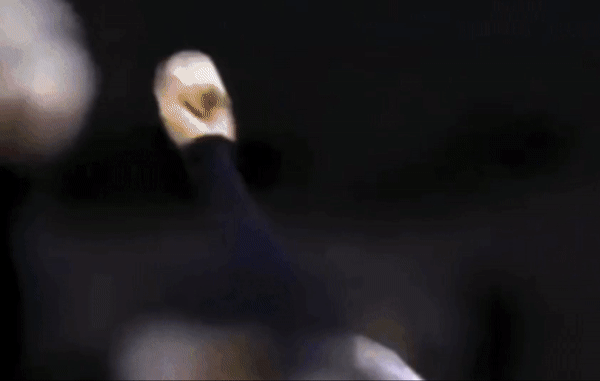
Overview
The cutter, a variation of the 4SFB, is a pitch that relies on a combination of backspin and gyro spin. By combining backspin and gyro spin, the pitch will move similarly to a 4SFB out of the pitcher’s hand, and eventually “cut” a few inches horizontally towards the pitcher’s glove side.
Generally speaking, a cutter will be thrown 3-6 mph slower than the 4SFB. The cutter isn’t considered an “off – speed” pitch due to the smaller discrepancy in velocity to the 4SFB compared to a pitch such as a curveball.
Ideally, when throwing both the 4SFB and cutter in your arsenal, the ability to tunnel both pitches is very desirable due to the similarities of the pitches out of the pitcher’s hand during ball release. However, some pitchers rely on the cutter as their primary fastball (Such as Corbin Burnes), and some use it later in counts to try and throw off hitters timing and generate strike outs. (Such as Kenley Jansen)
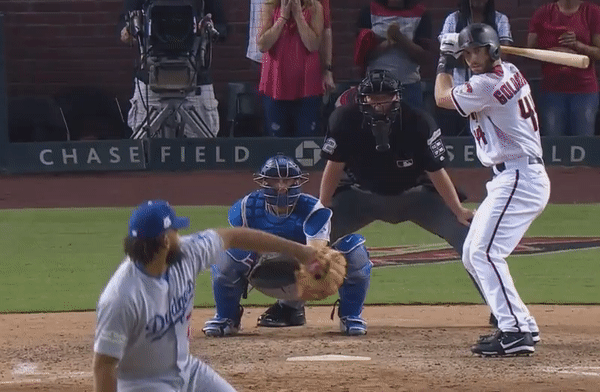
In this article, we will be taking a deep dive into a few different cutter grips and cues to help you throw your cutter more effectively and efficiently.
Desired Movement Profile
Before we talk about the tips and tricks on how to throw a better cutter, lets continue to discuss how we want this pitch to move.
Like we spoke about earlier, we look for the cutter to maintain backspin, while incorporating gyro spin into the mix as well. This means we will be looking for the pitch to maintain (+) vertical break, while also having a few inches of horizontal break towards the pitcher’s glove side.
The ideal movement for a cutter would have: VB > HB, more specifically:
-
- Around (+) 10 VB
- Around (+/-) 3-5 HB (Depending on R/L Pitcher)
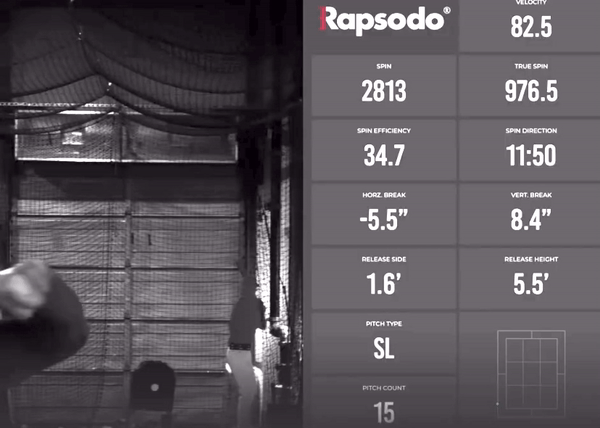
Ideal Cutter Location on a Movement Chart
A movement chart is a tool that players and coaches can use to analyze the ideal movement and placement of a given pitch.
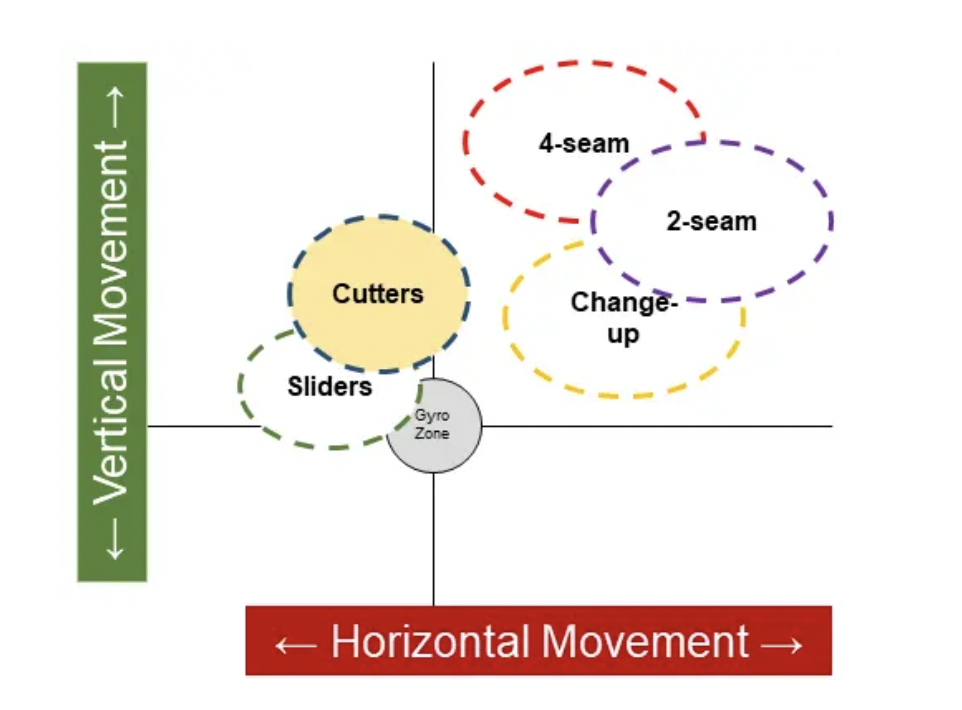
What each zone represents:
-
- The grey circle in the center of the chart represents the “gyro zone” which is no movement in either the vertical or horizontal plane.
- The upper right quadrant represents positive vertical movement and positive horizontal movement.
- The upper left-hand quadrant represents positive vertical movement and negative horizontal movement.
- The lower right-hand quadrant represents negative vertical movement and positive horizontal movement.
- The lower left-hand quadrant represents negative vertical movement and negative horizontal movement.
The chart pictured above is representative of right-handed pitcher’s ideal placement for each pitch. A cutter is a pitch that you want to maintain (+) vertical break, meaning it should always fall in the upper quadrants of the movement chart. In addition, the cutter will move horizontally 3-5 inches towards the pitcher’s glove side. (In this case, into the negatives) This puts the upper left-hand quadrant as the most ideal for right-handed cutter.
For lefties, the (+) vertical break would stay the same, but the horizontal movement that would be desired would have positive value. Therefore, making the upper right-hand quadrant the most ideal for a left-handed cutter.
Interested in learning more about remote programs, you can simply click below to schedule a phone call.
Cutter Grips
Below are various cutter grips we have used with success. You can try them all and see which is most comfortable.
Cutter grip #1:
Cutter grip #2:
Cutter grip #3:
For an expanded discussion on cutter grips click here.
Cues to Help You Throw a Cutter
Let’s start with this… throwing cues are NOT ONE SIZE FITS ALL!!
There are many different cues that people use when teaching pitchers how to throw each pitch. You need to find which cue best suits YOU and helps YOU throw your cutter more effectively.
Some of the cues that we like to tell our guys are:
-
- Trust the grip, throw it like a fastball
- Middle finger pressure, throw it like a fastball
- Come off the side of the ball, throw it hard
- Throw it like a football spiral
Another thing to focus on when throwing the cutter is where you will last touch the ball right before release.
If you cut the ball into 4 quadrants, you want to release the cutter off of the bottom right quadrant of the baseball. This will allow the pitcher to create backspin with the pitch while still adding some degree of side / gyro spin that will create the “cut” action you are looking for.
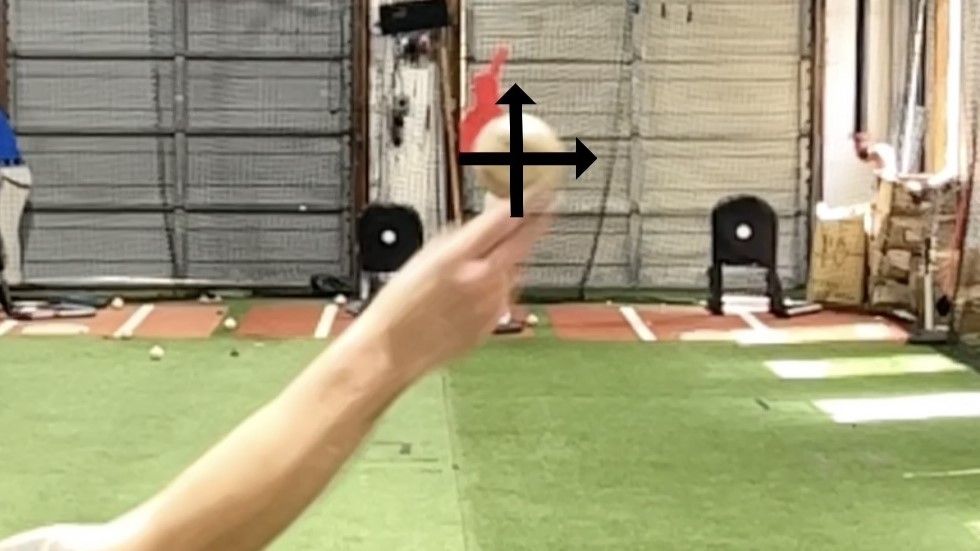
See video below for a visual example of what we are referring too…
Cutter Data: What we like… What we don’t like… (Specifically for athletes who have access to data tracking devices such as Rapsodo, Trackman, Pitch Logic, etc.)
What we like to see:
-
- Spin efficiency of 35-40% (or slightly higher)
- Velocity drop vs. 4-seam of about 3-6 mph
- A greater VERTICAL break (+) than HORIZONTAL (+/-)
- Glove-side lateral movement
- Relatively consistent spin axis from pitch-to-pitch
- Consistent spin efficiency
What we don’t like to see:
-
- Spin efficiency lower than 35% (as it begins to approach a slider)
- No glove-side break
- Somewhat inconsistent spin-axis from pitch-to-pitch
- Somewhat inconsistent spin-efficiency from pitch-to-pitch (the more inconsistent the spin-axis and spin-efficiency, the more inconsistent the break. This in turn implies less overall command of the pitch)
Tunneling Tips – When and Where to Throw a Cutter
The cutter is a great pitch to play off a 4SFB or SL.
Cutter / 4SFB – Both the cutter and 4SFB possess (+) VB. This allows both pitches to look similar coming out of the pitcher’s hand. Considering that the cutter will move horizontally towards the pitcher’s glove side causes the pitches to eventually separate and move differently in the later part of decent towards the plate. This can cause some serious deception between the two pitches and cause hitters to misread the two, causing timing issues and straight swing and misses.
Cutter / SL – Although not done often, the cutter can also be played off the slider. If you have the ability to spin both of these pitches, and not have them merge into one, this can be a very elite tunneling opportunity. Due to the fact that both pitches move in the horizonal plane, and move towards the pitcher’s glove side, it could allow for increased deception between the two pitches. The cutter and slider will look similar during the first half of decent towards the plate, and the slider will then continue to break more horizontally than the cutter as they get closer to the hitter. This will increase the deception between these two pitches, which will cause timing issues for the hitter as well.
Our suggestions for best times to throw a slider:
-
- 0-0 to get ahead, and disrupt the hitters timing
- 0-1 – after throwing a 4SFB, or slider (on 0-0)
- 1-1 – to set up the slider as the put away pitch with 2 strikes, trying to generate a swing or miss pitch for a strike out
Although these could be the more ideal times to throw a cutter, another good option could be using the cutter when you are behind in the count. Normally, when a hitter is ahead in a count, he expects the pitcher to deliver a FB to get back on track. This would be a good time to throw a pitch that looks like a fastball… but breaks a little differently than the hitter is expecting it. Thus, potentially resulting in weak contact or a swing and a miss.
Example of an Elite MLB Cutter
In this article we have already mentioned some of the MLB’s most elite cutters such as Corbin Burnes and Kenley Jansen. However, the cutter that we want to emphasize here is… Emmanuel Clase’s cutter.
This pitch is ELITE. Emmanuel Clase throws his cutter at 100 MPH!!! In addition to the high velocity on the pitch, it also comes in at 2600 RPM (+11VB, -3HB). In 2022, Clase threw his cutter 59.7% of the time. Clase’s cutter produced a .189 BA, .212wOBA, 22.5 whiff %, and 28.9 K%. The close out his arsenal, Clase throws a 4SFB and SL. This allows him to use his cutter of BOTH his 4SFB and SL, making his arsenal even more deceptive and effective. He is a great example when looking at the type of cutter to emulate.
By Jake Lebovitch (Pitching Coordinator, Strength Coach at RPP Baseball)
Articles in the How to Throw series:
You live too far to train with us in-house at RPP? You can now train with us on a REMOTE basis.


